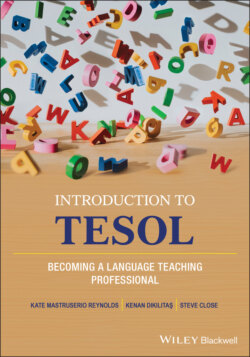Читать книгу Introduction to TESOL - Kate Reynolds - Страница 44
Our Professional Roots
ОглавлениеWhile second language learning has been occurring since different language speakers first interacted, the field recognizes two major milestones in our origins. The history of second/foreign language teaching begins with instruction in the classics of Greek and Latin in 1750 (Howatt & Smith, 2014). The second major milestone was the commencement of formal academic study of second language acquisition in the 1960s (Ellis, 2014). Many programs of TESOL/Applied linguistics date to the early 1960s as well and grew from university programs of modern languages and linguistics (Modern Language Association, n.d.). While TESOL teacher preparation programs may be found in university English or linguistics departments, they may also be located in departments of education of modern/world languages.
Since the mid-1960s when TESOL was emerging as a professional area of scholarship and teaching, the field has grown in the number of educators working in the field, but also in terms of breadth and impact. The numbers of individuals teaching English worldwide are difficult to determine. What can be determined is the number of members of the two leading professional development organizations. TESOL International Association reports 13,300 members and International Association of Teachers of English as a Foreign Language (IATEFL) indicates membership of over 4,000 in 2016 (Hill, 2019), although many more professionals work in the field despite not being part of these professional development associations.
The diverse areas of study in our discipline illustrate the broad focus of research, teaching, and assessment. Initially, TESOL’s primary areas of interest were linguistics, language learning processes, and language skill instruction (i.e., grammar, pronunciation, speaking, listening, reading, and writing). These areas continue to be discussed and developed through new ways to engage learners and an expansion in our understandings of the nature of language learning. The field has grown in many different directions over the years. Focuses include investigations into language learning processes in various contexts and the influences of identity, anxiety, and cultural factors impact on learners’ language learning, participation, and motivation inform our teaching. The study of the qualities of language learners who excel at language learning (“good language learners”) yielded instructional practices in explicit teaching of language learning strategies that help learners remember new language, analyze their language use, cope with anxiety, and compensate for lack of a vocabulary word. Discussion of equity in work environments resulted in educators supporting nonnative English-speaking teachers. A study of the nature of authentic language use led to development of the “communicative competencies,” which we use to guide our learning objectives. Later, authentic language was analyzed in huge corpuses (i.e., databases) with computerized search mechanisms that allowed us to isolate words or phrases to see how they were used in spoken or written language. Now, textbooks utilize this information when authors select high-frequency vocabulary for study as opposed to words that might be used.
While the field continues to expand in breadth and depth, TESOL/Applied Linguistics is contributing to education worldwide in significant ways. Developments in TESOL/Applied Linguistics are applied in the instruction of world languages (i.e., Arabic, Chinese, and Spanish). General educators in many countries now have an awareness of the differences between language used in social interaction and that used in academic interaction. This information has helped educators become more aware of the language demands of their academic subject, so they may make learning more accessible for all learners and not just ELLs. World-Class Instructional Design and Assessment (WIDA) developed “can do” indicators in their initial proficiency guidelines, which many educators now employ in classes to share learning objectives with students.
